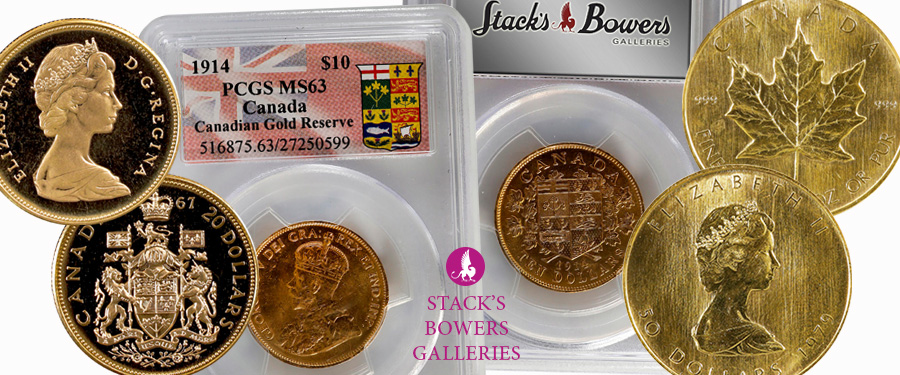
Canada was awash in gold in the early 20th century, the result of major gold strikes in Northern Ontario and the Klondike from the mid-1890s to the early 1910s. Among the reasons for establishing the Royal Canadian Mint (RCM) in 1908 was to convert the amassed gold into circulating coinage. The Currency Act of 1910 authorized gold denominations which echoed those then in production in the United States: $2.50. $5, $10, and $20. Only the $5 and $10 denominations were produced, with the new coins the same size and weight as United States gold half eagles and eagles. According to Canadian coin experts and the RCM’s account, the gold used for the 1912-dated coins originated primarily in the Klondike; that used on later dates was primarily from Ontario. E.B. MacKennal’s portrait of King George V appears on the obverse of both denominations, while Canada’s coat of arms, the Arms of the Dominion of Canada, encircled by a maple leaf wreath is found on the reverse.
Both series proved short lived, as production ceased after 1914. The majority of the coins ended up in government vaults, especially as the First World War pushed the government to maintain its gold reserves; a relatively small portion did enter circulation. Nearly a quarter-million remained in government vaults (and, after 1935, in the Bank of Canada) for close to a century.
The $5 and $10 gold coins of 1912-1914 were not the first gold coins produced by the Royal Canadian Mint, but the first struck under the authority of the Canadian government. British gold sovereigns were struck at the Ottawa Mint from 1908 to 1919. Some debate exists as to whether these should be regarded as “Canada’s first gold coins” but a rough numismatic consensus seems to be that the 1912-1914 series represents the RCM’s first truly Canadian gold coinage foray.
About a decade ago, the Bank of Canada and RCM prepared to sell off (or melt) the 1912-1914 $5 and $10 coins held as part of the Government of Canada’s Exchange Fund Account; the Bank of Canada had held the coins since it opened in 1935. Around the time of the sales, which began in November 2012, RCM staff sorted the coins (the vast majority of which were Uncirculated, the result of having been in BOC vaults for 75 years) into two quality tiers: Hand-Selected and Premium Hand-Selected. 1913 and 1914 $10 coins constituted most of the coins offered. Third-party grading services produced labels for the coins attesting to their origins from Canada’s gold reserves.
Jeff Starck’s reporting of the sales in Coin World in 2012 offers a helpful narrative: https://www.coinworld.com/news/world-coins/rcm-selling-century-old-gold-5-10-coins.html
Canada would not again produce its own gold coinage until 1967 when the RCM struck $20 gold coins to commemorate the centennial of Confederation. In 1979 the Maple Leaf series of gold bullion coins was introduced.
Interested readers might also visit:
https://coinweek.com/canada-melts-first-circulating-canadian-gold-coins/
Examples of all three series appear regularly in Stack’s Bowers Galleries’ weekly Precious Metals Auctions. For more information, please visit our website.





